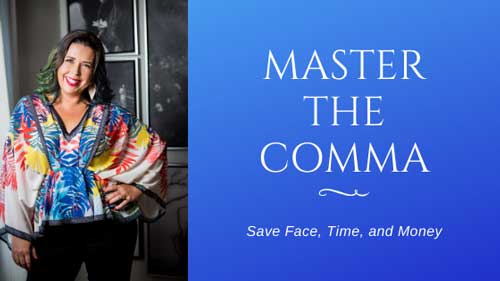It almost always elicits a reaction from writers. Either they geek out on the complexity of the comma, or they cringe and feel embarrassed about what they don’t know.
I usually meet writers in the latter camp, who apologize because of their comma usage. I once had a client tell me: “a box of commas got loose in my manuscript.” I always want to hug these folks.
There’s no shame in not knowing when and where commas are needed. But the writer who cares about her craft, and plans to be a writer her whole life long, needs to educate herself about how sentences are put together. It’s important to understand the mechanics of writing, especially the fundamentals of how to use commas.
Comma Chameleon
Commas are punctuation chameleons. Just like the lizard that can change its coloring and markings to blend in with its surroundings, the comma changes its purpose based on its placement in a sentence.
A comma’s main purpose is to indicate a break in structure; it’s NOT intended to indicate a pause as many writers believe.
And the comma’s placement determines how it functions. The comma is the most flexible punctuation mark, and it has more uses than any other punctuation (think 15!), which is why it can be so difficult to master.
But master it you should.
Write with Confidence and Freedom
I once had the pleasure of hearing grammarian Michael Clay Thompson speak. My takeaway was that it was important for students to learn grammar because then they could manipulate words and write whatever they want.
I feel the same about commas.
When a writer understands how to correctly use the comma in all its many forms, then she can wield that comma to add depth and nuance to her words. She can strengthen her voice. She can play with her style.
Knowing how to use commas effectively means she can write whatever she wants. She doesn’t have to consider a workaround because she’s not sure where the commas go. She doesn’t have to apologize to her critique partner for randomly sprinkling commas in her manuscript, as if it were a dish in need of seasoning. She doesn’t have to fret that her manuscript will be rejected because readers can’t make meaning of her sentences.
Transform Your Self-Editing Practice
Not only does understanding the comma allow the writer a newfound mastery over her writing, it will transform her self-editing practice.
I have lots of tips to boost self-editing skills, but if a writer doesn’t know what to fix, then none of those tips are helpful.
Remember, just because a writer did well in English doesn’t automatically mean she knows her commas.
There are “rules” to follow, rules crafted by the Chicago Manual of Style, the style guide of choice in the American book-publishing community.
There are, of course, other style guides used: MLA, APA, and AP, to name a few. And every style guide has its own “rules” about comma usage. Sometimes those rules overlap with Chicago’s preferences, and sometimes they don’t.
And this often confuses folks.
If the person who taught a writer foundational grammar, and comma usage specifically, wasn’t following the Chicago Manual of Style (and I’ve never met a teacher who was), then it’s quite likely that a writer isn’t always adhering to the comma usage guidelines for books.
The Rules
I divide comma usage into categories:
Commas to Always Use
Commas to Never Use
Commas to Use Like This, But Not Like This
Commas to Choose
For example, if a writer doesn’t solidly understand why she used a comma with a compound predicate, then she can’t confidently defend that choice when her well-meaning but intimidating critique partner flags it. Or her enthusiastic editor misses the nuance of her writing voice and deletes it.
A writer needs to know the rules so she can stand by her choices, especially if she’s breaking the rules on purpose.
Not only that, understanding comma usage allows writers to play with nuances and pacing and more.
Beware the Helpers
Finally, be wary of software programs designed to improve your writing. Yes, use them. But use them with caution.
Just because a comma is flagged doesn’t automatically mean it’s incorrect. Or the opposite — just because a comma is suggested doesn’t mean it’s necessary.
But if a writer doesn’t understand comma usage, she may accept the program’s recommendations as “expert” advice. Worst still, this can introduce errors into a clean manuscript.
Empowered Writers
Comma mastery is absolutely attainable for every writer. Empower yourself as a writer who studies her craft (and knows her commas), so you can share your messages and stories with confidence and creativity.
An Invitation
If you’re ready to master the comma, I’m offering a live round of Master the Comma: Save Face, Time, and Money, a 5-week online course for writers.
The course begins January 9 and includes more than twenty easily digestible video lessons, opportunities for authentic practice, a Q&A call, and even a dance party invitation.
Photo Credit: Cass Bradley
 Nicole Ayers is the owner and editor of Ayers Edits. Editing is her dream job because she gets to combine her love of reading with the fun of wordplay. In addition to providing one-on-one client consultations, developmental editing, and line editing services, she creates online courses, including one all about commas. Nicole shares an informative weekly newsletter called An Editor’s Teaching Corner for Writers and hosts FB Lives to share what she knows about writing and editing. Sign up for her newsletter and connect with Nicole on Facebook: @AyersEdits.
Nicole Ayers is the owner and editor of Ayers Edits. Editing is her dream job because she gets to combine her love of reading with the fun of wordplay. In addition to providing one-on-one client consultations, developmental editing, and line editing services, she creates online courses, including one all about commas. Nicole shares an informative weekly newsletter called An Editor’s Teaching Corner for Writers and hosts FB Lives to share what she knows about writing and editing. Sign up for her newsletter and connect with Nicole on Facebook: @AyersEdits.
Nicole is a member of the Charlotte chapter of WNBA and served as Editor-in-Chief of The Bookwoman from 2017-2019.
Liked this post? Check out more of the Bookwoman Blog.

Leave a Reply